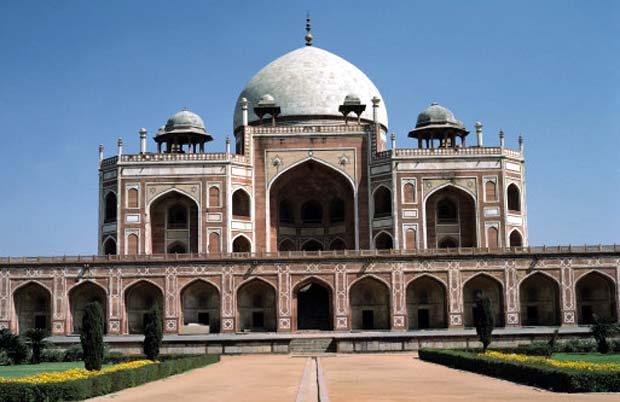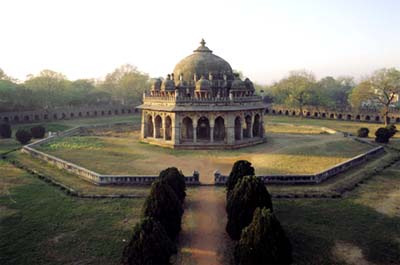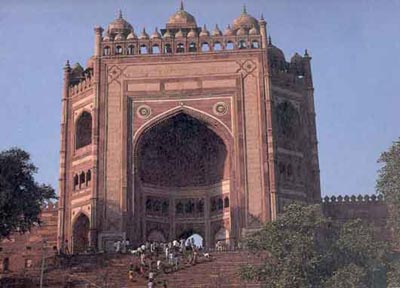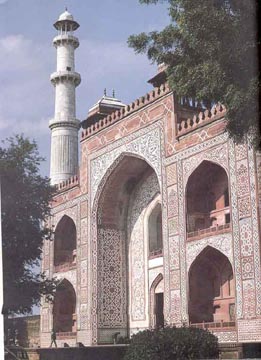Dec 07, 2025
Dec 07, 2025
The first of the Mughal emperors, Babur, in spite of his keen aesthetic sense, did not have the time to embark upon a concerted program of building. The mosque built by him at Ayodhya - the Babri Masjid – is now history, in an incident that must surely rank as one of the most shameful points of the history of independent India, when the rule of law and justice for all was subjugated to the will of a few gangsters acting in the name of religion. An act supposedly demonstrating Hindu pride did nothing but lower the image of India in the whole world.
Humayun’s Tomb

Luckily the first great Mughal construction, Humayun’s tomb near Nizam-ud-din in Delhi, has come down to us mostly intact, though this too suffers from neglect due to the pitiful funds allocated to the Archaeological Survey of India, and the callous way in which we treat our built heritage.
 This was the first mosque built on the lines of the Charbagh, gardens with fountains built on the Islamic concept of paradise being ‘gardens in which flow torrents of water’. Its construction was undertaken by the late emperor’s widow, the Hamida Bano Begum, in the reign of Akbar. While image above shows the Humayun Tomb, the image to the right shows the Humayun library - a part of the Humayun Tomb complex.
This was the first mosque built on the lines of the Charbagh, gardens with fountains built on the Islamic concept of paradise being ‘gardens in which flow torrents of water’. Its construction was undertaken by the late emperor’s widow, the Hamida Bano Begum, in the reign of Akbar. While image above shows the Humayun Tomb, the image to the right shows the Humayun library - a part of the Humayun Tomb complex.
The tomb is entered by a long axial processional path, which has on its way great gateways offering teasing views to the superstructure. The tomb itself is raised on an arcaded platform, under which can be found numerous lesser graves, which are ascribed to various nobles and workers who served Humayun. A great central chamber has four offshoots, double storeyed in height and arcaded on their facades. The central room contains the epitaphs of the emperor Humayun and his queen, and is crowned by great double dome.
On the exterior, the tomb is clad in red sandstone with marble being used for detail work and inscriptions. Also continued here is the jali work along the facades, rich in detail, which keeps the interiors cool and breezy.
The terrace of the tomb, accessed by staircases, offers a panoramic view of the city, and although the nearby railway line succeeds in disturbing the peace, the nearby Yamuna flowing slowly, as well as the remnants of forest which still exist, continue to offer the sleeping Emperor solace as one of the founders of the great Mughal empire.
Badshahi Masjid, Fatehpur Sikri
 The Badshahi Masjid is the largest and most impressive mosque built during Akbar’s reign, and its central court is dominated to the south by the Buland Darwaza, already discussed in a previous article.
The Badshahi Masjid is the largest and most impressive mosque built during Akbar’s reign, and its central court is dominated to the south by the Buland Darwaza, already discussed in a previous article.
The materials used are the same which dominated much of Akbar’s reign, a preponderance of sandstone with marble filigree and detailing. The prayer hall to the west is a departure from the free-standing Afghan mosque halls like Jamali-Kamali near the Qutb, or the Qila-i-Kuhna at the Purana Qila, and is instead integrated into the pillared cloisters.
Added later during Jahangir’s reign, the dargah of the Sufi saint Salim Chisti was designed in sandstone during Akbar’s reign, but was eventually executed wholly in marble.
Akbar’s Tomb, Sikandra
Sikandra is a sleepy little outpost on the outskirts of Agra, and its main claim to architectural fame is the presence of Akbar’s tomb. As was so often the case, it was built by his son Jahangir.
 Akbar’s tomb, continuing the charbagh formula, is set in the midst of gardens with fountains and canals, and like Humayun’s tomb, is also raised on a superstructure. Here, however, the similarities lessen, because in plan and detail, Akbar’s tomb takes much from the indigenous Rajput and Gujarati traditions.
Akbar’s tomb, continuing the charbagh formula, is set in the midst of gardens with fountains and canals, and like Humayun’s tomb, is also raised on a superstructure. Here, however, the similarities lessen, because in plan and detail, Akbar’s tomb takes much from the indigenous Rajput and Gujarati traditions.
The pavilions inside are decorated with motifs ranging from elephants, swans, lotus, swastika and chakras, along with the more conservative arabesques and calligraphy.
Apart from these monuments, we may also enumerate several lesser known structures built during the same period. Among these are Jahangir’s tomb at Shahdara near Lahore which reflects the influence of Sikandra, Itmad-ud-Daula’s (Jahangir’s father-in-law) tomb at Agra, mosques at Tatta and Ajmer, the Begam Shahi Masjid of Akbar’s widow at Lahore, and the Patthar Masjid of Srinagar. This last is one of the few notable mosques built during Jahangir’s reign. The emperor Jahangir, for all his taste, was too wasted by alcohol and sensual pleasures to ever embark seriously on military or architectural campaigns.
The growing richness of the Mughal empire brought with it traders and merchants, who were eager to make a quick profit. India was at that time running a lucrative spice trade with foreign powers such as the Dutch, the Portuguese, the French and eventually the English. The Mughal court was close to its zenith, and seemed to have no equal or challenger.
But appearances are often deceptive, and as is the case with too much prosperity, decadence was about to set in. But not before the Mughals had built some of the most impressive monuments in the world.
Images of Humayun Tomb and Humayun library under license with Gettyimages.com
15-Jun-2003
More by : Ashish Nangia

|
The picture shows the GATE to Akbar's Tomb, not the Tomb itself. |

|
bahot khubsurat si aur bhi photo hai mughal samarat ki |

|
dear readers thanks ever so much for your encouraging comments I hope we continue serving the cause of architecture and appreciate talent whever it may be. |

|
MUGHALS SERVED THE BEST ARCHITECTURE TO INDIA,I AM PROUD TO BE AN INDIAN |

|
where were the mughal ladies buried and can you say the list of all mughal emperors and empress tombs around india and in india |

|
IT IS VERY IMPORTANT ABOUT E DUCATION LIKE HISTORY . AND I LIKE IT. |

|
nice article nice language |

|
good article BY ASHISH NANGIA |

|
good article and clear pictures |

|
verey good |

|
good article |